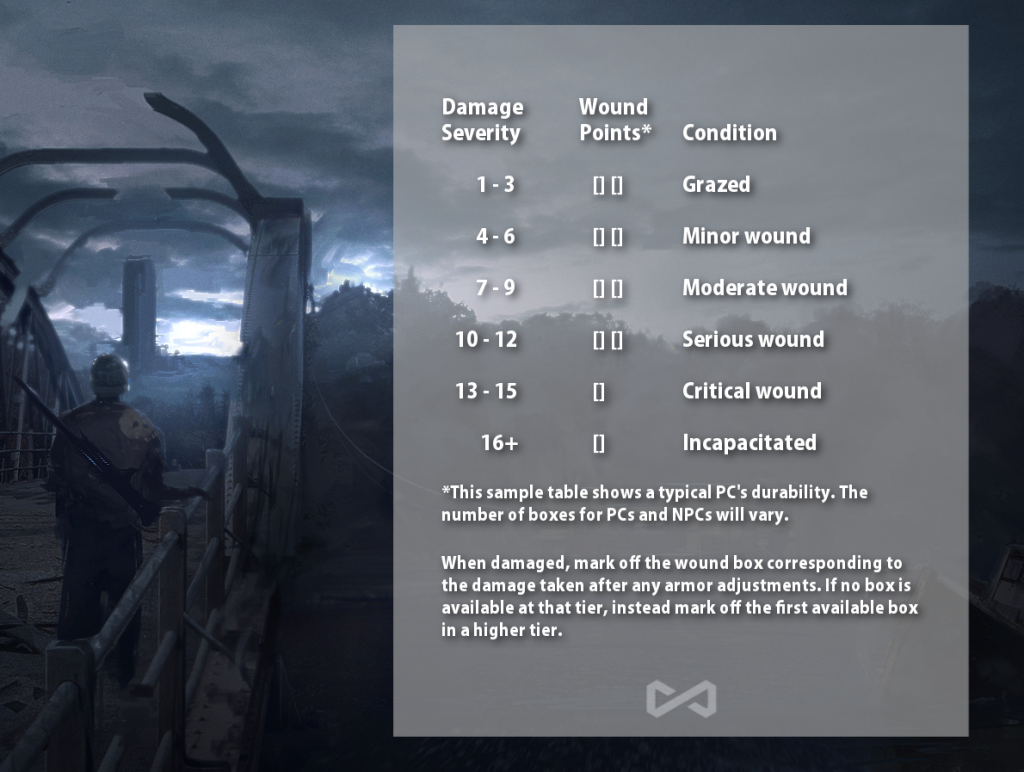 In today’s blog, we’re taking a look at the current iteration of our take on Alternity’s damage and wound system. As with other sneak peeks at our design, this is a snapshot of a work in progress, and we expect to continue to refine and adjust the systems as we get closer to launch. Read on!
In today’s blog, we’re taking a look at the current iteration of our take on Alternity’s damage and wound system. As with other sneak peeks at our design, this is a snapshot of a work in progress, and we expect to continue to refine and adjust the systems as we get closer to launch. Read on!
The core concept of the damage system was proposed by Dave, who suggested the idea that characters work through multiple levels of severity of injury, with the severity determined by the incoming damage reduced by any armor worn by the target. Instead of accumulating points of damage, each hit would be a wound, and the character then would take a penalty based upon the most significant wound. Wounds would be one of five categories, based on a 10-point damage range.
We iterated on this concept to get to where we are today — still very similar in that there are five categories of wound (and a sixth category to denote incapacitated/dead) but we’ve expanded the range to a 15-point scale, which gave us greater variance for differentiating the types of weapons that might be used.
In this system, a hit from a weapon still deals the weapon’s damage, reduced by any sort of armor worn by the target. But the amount of damage doesn’t represent hit points, but instead represents the severity of the wound. An Average pistol hit might do 4 or 5 damage, and be reduced to merely 1 or 2 by an armored vest, for example, whereas a Stellar hit from a blast cannon might deal 10 or 12 damage after armor is applied. The target then marks off a wound box corresponding to the damage dealt. If the target has no available wound box at that severity, then a box in the next-highest tier is marked off. A wounded character’s Condition is determined by the most significant wound taken. A hit or two in the 1-3 tier won’t hamper a typical character very much, but as the character progresses through moderate, serious, or critical wounds, he’ll take a progressively worse penalty on his rolls (as denoted by a step penalty on the PC’s Situation Die).
For most characters, a couple of big hits can incapacitate a character pretty quickly. But so can a whole bunch of smaller hits, since a hit on a character who has filled up lower tiers with small hits can easily become a more significant wound. The image below shows what a typical PC’s wound chart might look like:
We like the system because it captures the notion of taking wounds, and lets big hits feel more substantive, especially early in fights — compare it to a traditional hit point system where a character (or foe) is at 100% until the numbers run out. It’s also somewhat lightweight, with no math involved for tracking hit point totals, which helps combats move more quickly. It scales nicely with NPCs/monsters as well, since we can make stormtroopers or other grunts that might go down with one well-placed hit or a couple small hits, but we can also create giant mechs with more wound boxes that satisfy a climactic encounter. We can even change the conditions for different foes — the 10-12 tier for a walking tank might reduce the tank’s movement or rate of fire, for example, instead of just applying a flat 1-step penalty.
PCs can be similarly varied — a class or talent choice might provide extra wound boxes. Imagine a brawler that can just absorb a pile of smaller hits, or a survivor that has one extra critical wound box, making him that much harder to finish off. This system gives us a lot of flexibility.
For weapon damage expressions, we experimented with static damage numbers as well as rolling damage. While static numbers were a bit faster, we missed the added fun of rolling for damage. Also, using a die roll helps us differentiate different types of weapons. For example, clumsy, random weapons like a blaster cannon can be illustrated with larger variance, while precise laser beams can be designed to be more consistent.
As the system came together, we realized that having three different success levels meant that we needed the damage system to provide three tiers of results. An average hit needs to feel meaningful, but an Excellent or Stellar result has to visibly improve the result. When we began, we started with the idea that a standard pistol might deal 1d6+1 damage at the Average result, and then expand to 1d6+3 and 1d6+6 for the Excellent and Stellar results. But we observed that the Stellar result isn’t very satisfying when there’s a 1 in 6 chance of it being not any better than the “best” average result. We needed to differentiate them more.
We found the best option was to simplify the system a bit. Instead of having three damage expressions for each weapon, we went to two expressions that were more distinct. That pistol from the previous paragraph stayed at 1d6+1 for average results but improved to 1d6+6 for Excellent results. A Stellar result needed to feel more like a critical hit (since most of the time it’s about the same odds), and so now deals the Excellent damage plus an additional wound.
 Of course, we’ll continue to tinker and adjust the system, especially once we get the playtest files out and start getting feedback. We’re gearing up the first packet, and it will be available soon! Here’s a look at page 1 – Click to embiggen! (also realize this one isn’t final – we’ve yet to add the links for contact info, for example):
Of course, we’ll continue to tinker and adjust the system, especially once we get the playtest files out and start getting feedback. We’re gearing up the first packet, and it will be available soon! Here’s a look at page 1 – Click to embiggen! (also realize this one isn’t final – we’ve yet to add the links for contact info, for example):
If you’re still keen on joining our playtest, head over to our Playtest Signup post and give us your email address!

